For The Best Pan Pizza there’s no getting around it. Sometimes you have to plan ahead in the kitchen.
If you want to make the very best pizza you’ve ever had, you’re going to need to start the process at least 10 hours but up to a day ahead of when you’d like to eat it. It doesn’t really require any skill-set beyond patience and the ability to follow four simple sets of directions.
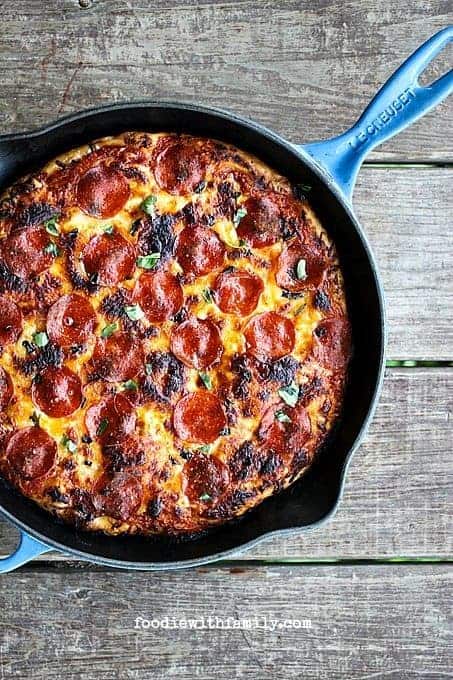
How to Make Pan Pizza
- 1. Measure, mix, and wait.
- 2. Divide, oil, and wait.
- 3. Top, bake, and wait.
- 4. Remove, slice, and wait.
Are you catching the theme? There’s a lot of waiting.
There’s NOTHING complicated but patience is non-negotiable. If you have a kitchen scale, this is the moment to break it out.
Measuring your flour, water, oil, salt, and yeast by weight insures that the only variables are ones outside of your control: humidity and heat. You can compensate for humidity and heat, but you can’t compensate for four ounces too many of flour because you didn’t measure correctly.
That’s right, I said it. Measuring precisely here is actually of paramount importance.
This is not a case where you grab that teacup your mom or grandma always kept in the flour bin, plunge it into the flour, and squish it up against the edge to pack it level. Just don’t.
This is a job for a scale that weighs in ounces, or -in a pinch- an occasion when you use a spoon to dip into the flour, shake it gently over the cup that you’re not shimmying in any way, and repeat until the cup is a little over full, then you use a flat edge of a butterknife or a spoon handle to level it off.
I’m not kidding you. You do not want a ‘workable’ dough that you knead.
You’re going to stir it all together with a spoon, cover it, and let it go overnight or for at least 8 hours. Yes, it sits on the countertop that whole time and does not go into the refrigerator.
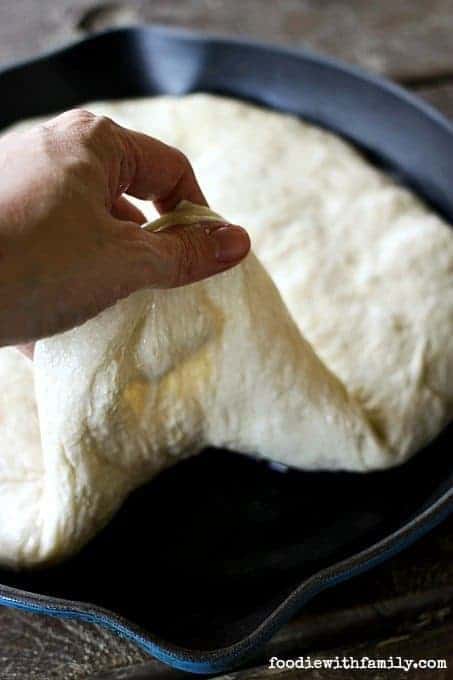
You’re seeking a slack dough. In fact, you’re looking for the kind of dough that will spread itself out in a well-oiled cast-iron skillet because that is exactly what you’re going to let it do.
Yes. No-knead dough that spreads itself in the pan.
Do I have you now? Once you get to that point, the toughest part is over with, unless you include the inner battle to avoid biting down on molten hot pizza that will remove the first layer or two of skin from your mouth.
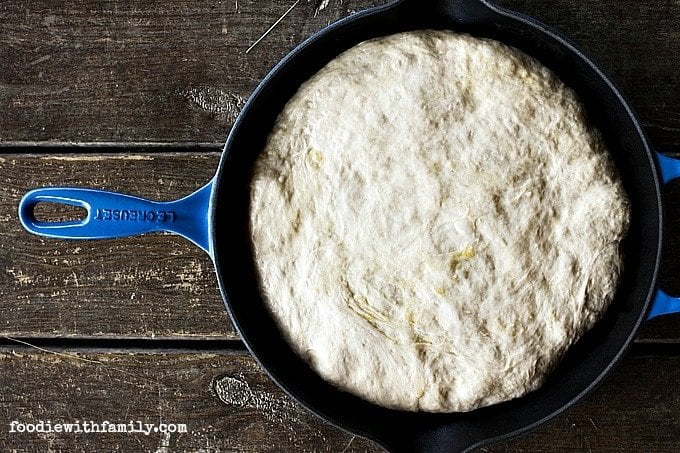
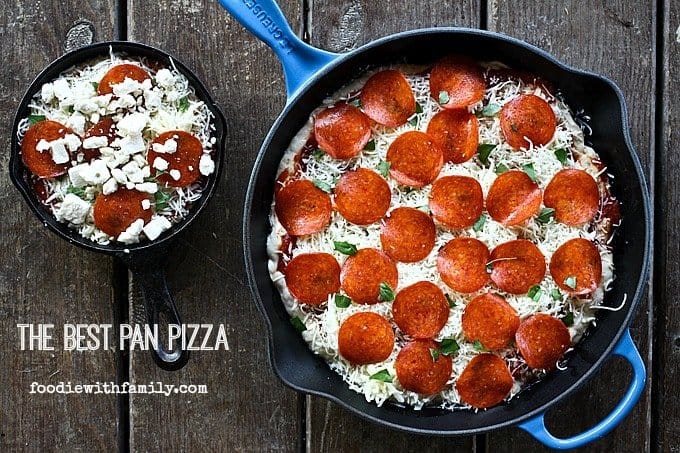
All that remains is to poke any extra large air bubbles with the back of a knuckle, lift the dough around the edges to eliminate any trapped air bubbles, and top it. Aside from the fact that the dough is DEAD easy as long as you know how to properly measure, there’s more to recommend this method.
Pan Pizza
EVERYTHING is assembled in ONE PAN. The dough spreads in one pan, is topped in the same pan, then cooked in that same pan.
You don’t have to muck up and dirty all kinds of dishes, remember to preheat a pizza stone, or fiddle around with a pizza peel to make this one pizza to rule them all. All you need is a solid, cast-iron pan or two and a dose of “I’ll wait for what’s great.”
If I had to compare the Best Pan Pizza to one that’s commercially available, I would first say, “Pffft. This is better than any commercial pizza.” then I would grudgingly admit it’s rather like the Pizza Hut Personal Pan Pizzas of my youth.
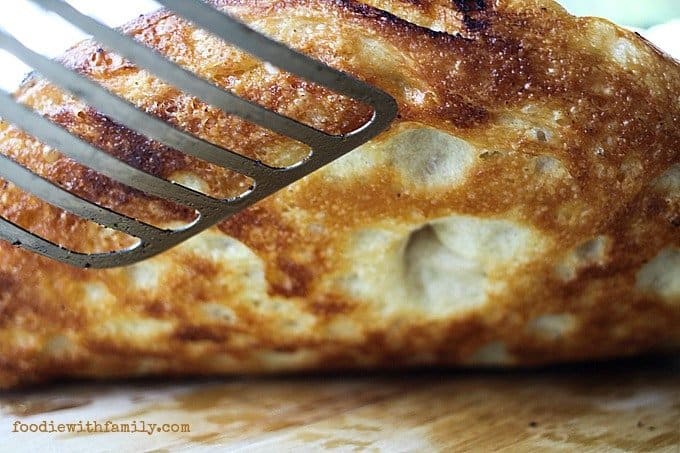
I loved those oil soaked, crispy bottomed, chewy little pieces of pizza heaven. The Best Pan Pizza is a little thicker than a thin-crust, but nowhere near the whole gloppy Deep-Dish pies of Chicago.
(Not that there’s anything wrong with those, but they’re just not what we’re looking for in your every-weeknight-pizza.) They are -in short- chewy, fried-crust, pizza perfection.
What kind of flour to use for Pan Pizza
The recipe specifies high-gluten (or bread) flour. This is not the same thing as all-purpose flour.
It has a higher protein (read: gluten) percentage which yields a chewier/holier dough. You will not get the same results from all-purpose flour, so it is best to seek out the high-gluten flour if it is available to you. (King Arthur Bread Flour has an excellent protein percentage for this pizza dough.)
Can you use all-purpose flour? Yes. It just won’t be the same. That said, you can definitely make it and it’ll be tasty; just different.
Can you use gluten-free flour? I honestly do not know. I’m sorry.
Gluten-free baking is a whole different field than my specialty. There are some folks who have weighed in on it in the comments section. Scroll through and maybe you can find some help!
How much flour and water to use for pizza dough
Body temperature water (just under 100°F) is the temperature of water you want to use in your dough!
Because baking is art as well as science, KEEP EXTRA WATER ON HAND when mixing your dough.
If you live somewhere humid, you’ll use all the water in the recipe, still. If you live somewhere arid, like the desert, you may need as much as 1/4 cup more water!
For the best results, use the dough in the video on this post as a visual cue for how it should look when just right.
As for flour, definitely weigh it out! I mean it! Don’t be tempted to add more flour to the mixture.
The dough should come together easily even if it looks shaggy. A dough whisk is your best bet for mixing thoroughly. Believe me, you not only don’t have to knead this dough, but you SHOULDN’T knead it.
The long, slow rise with a small amount of yeast allows the dough to fully develop the gluten that provides that lovely, holey structure.
The best cheese for pan pizza
When selecting which cheese to use, keep in mind that the Best Pan Pizza is not a good candidate for fresh mozzarella. The delicate texture and flavour would be lost in the blast-furnace that your oven is going to become.
You’re far better off buying a block of whole or part-skim mozzarella and shredding it yourself. Less great than block cheese grated yourself, but still better for these pizzas than fresh mozzie, is pre-grated mozzarella cheese.
Homemade Pan Pizza
Don’t make a mistake and choose too small of a bowl to mix/rise the dough in. This is going to expand to about eight times its original size, so use a very large mixing bowl, dough rising bucket, or a big old, non-reactive (stainless steel for example) pasta pot.
Store the rising dough, draft-free and at room temperature!
Pan choices count for your Best Pan Pizza. IDEALLY you will use two very heavy cast-iron, 10-inch skillets. If you don’t have two of those, you can use a 12-inch and an 8-inch or a 10-inch skillet and an 8 or 9-inch cake pan.
I used 12-inch and 10-inch enameled cast-iron Le Creuset skillets for both of my pizzas (and a bonnie wee 5-inch cast-iron skillet for another batch) and they were PERFECTION.
I used a cake pan for the second batch and while it did an admirable job, it didn’t get the crusty-bits I love so dearly up the side the way the Le Creuset skillets did.
Pan Pizza Recipe
Let’s talk oils. You want to choose one with a HIGH-smoke point because of the high-temperature of the oven.While extra virgin olive oil sounds like it would go with pizza, it’s a poor choice here because of its distressing tendency to billow smoke at any temperature above 375°F.
A better choice is regular old pure olive oil, but an even better choice is grapeseed or peanut oil. Canola oil or vegetable oil will do well if that’s all you have handy!
Speaking of oil, don’t skimp on the oil in the pan! It does triple duty here.
First, it allows the dough to spread itself easily, reducing or eliminating the friction it would experience against the pan. Second, it adds another layer of cooking to the exterior of the crust, essentially frying it as it cooks. Third, it’s just plain yummy.
Fire that oven up and don’t wimp out! Get your oven as hot as it can go for the cooking process.
That BURST of heat develops a bajillion little bubbles in the dough that helps lend to the chewy, hole-ridden texture so desired in a pan pizza. If you can get your oven up to 550°F (which is as high as my oven goes) DO IT.
If you can’t, just get it as hot as you possibly can shy of setting it on fire. Trust me.
Your oven goes no higher than 450°F you say? I’m sorry, that stinks. HOWEVER, we can work around it. This is where the ideal pan comes into play.
In this case, you take the pizza fresh from the oven when your toppings look just right, and set it directly on a hot burner to help crisp up the underside of the crust, lifting the edge carefully with a spatula or tongs from time to time to peek at the underbelly. When it looks deep brown and crisp, slide that pizza right onto a cutting board.
Let the pizza rest a bit before you cut it, if you value your skin. These things are HOT HOT HOT when they come out of the oven.
Let it rest at least 5 minutes, then slice it, then let it rest another 3 minutes before picking up your pizza to nosh on it. This will keep your precious mouth skin where it belongs: attached to you.

Use this to make The Best Pan Pizza
See how easy it is to make the Best Pan Pizza?
Calling all you pizza maniacs out there! After you try our Best Pan Pizza, be sure to try our Pickle Pizza, Figgy Pig Pizza; Tuscan Style Prosciutto, Fig, Greens Pizza, Smoked Salmon Cucumber Pizza, Honey-Drizzled Salami Pizza, and Roast Beef and Caramelized Onion Naan Pizza {10 Minute Meal}

The Best Pan Pizza
Rate RecipeIngredients
For the dough:
- 14 ounces bread flour 3 cups by volume
- 2 teaspoons kosher salt 3/8 of an ounce or .35 ounces
- 1/2 teaspoon instant yeast 0.06 ounce or 1.5 grams
- 1 1/2 cups water (12 ounces)
For the Pizzas:
- 4 tablespoons olive oil or neutral oil with a high smoke point like grapeseed such as peanut, or canola, divided (no extra virgin olive oil)
- 1 1/2 cups thick pizza sauce homemade or purchased
- 2 cups shredded mozzarella cheese
- 12-16 pieces of pepperoni per pizza
Optional but tasty:
- fresh basil leaves for adding before and after baking
Instructions
- Mix together all of the dough ingredients until it is evenly moist and there are no more pockets of dry ingredients. Cover the bowl or dough bucket tightly and let it rise for at least 8 but up to 24 hours.
- Pour 2 tablespoons of neutral oil into a 10 to 12 inch cast-iron skillet. Repeat with a second skillet. Swirl to coat the bottoms of the pans. Divide the risen dough into two pieces. Gently form into a ball by pulling the side of the dough and tucking it under, rotating 1/4 turn and repeating the tug and tug, rotating another 1/4 turn and repeating the tug and tuck, then finally doing it once more to form a loose ball. Lay it smooth side down in the oil, then flip so the whole thing is coated in oil. Use the palm of your hand to gently flatten the dough. It will not spread to the edges yet, but that is okay. Cover the pan tightly with plastic wrap and set out at room temperature -undisturbed- for 2 hours.
To Prepare the Pizzas:
- Preheat oven as high as it will go, preferably to 550°F. Remove plastic wrap from the pans with the pizza dough in them. The dough should now have spread itself (or nearly spread itself) to the edges of the pan. Simply lift the edges of dough to pull toward the sides of the pan if necessary. This will help loosen any trapped air under the dough as well. If there are any large air bubbles, nudge them down with the back of a knuckle.
- Spread half of the sauce on each pizza right to the edges of the dough. Divide the cheese and top each pizza evenly to the edge, then distribute the pepperoni over the pizzas. If using it, tear half of your basil leaves and toss over the tops of the pizzas. Reserve half of the basil to add to the pizzas when they’re removed from the oven.
- Put into the hot oven and bake for 12-20 minutes (depending on how well done you want your pizzas.) You can check the underside of the pizza crust for doneness by lifting the edge gently with a flexible spatula (like a fish turner). A finished pizza will have a crisp, deep-brown bottom and a bubbly, golden- to deep-golden brown top. I pull my pizzas when the edges have some deeply caramelized (read: lightly charred) edges and some dark brown bubbles on top.
- Use your flexible spatula to slide under the pizza and edge it out onto a cutting board, tear the remaining basil and scatter over the pizzas. Let rest for 5 minutes before slicing into wedges, then let it rest without moving it for another 3 minutes before serving.
Video
Nutrition
Nutritional information is an estimate and provided to you as a courtesy. You should calculate the nutritional information with the actual ingredients used in your recipe using your preferred nutrition calculator.
did you make this recipe?
Make sure to tag @foodiewithfam on Instagram and #hashtag it #foodiewithfamily so I can check it out!
Are you a big fan of the Best Pan Pizza? Try these other best recipes!
- Best Middle Eastern Salad Dressing
- Best Thing Tomatoes
- Best Way to Cook Salmon – Air Fryer Salmon
- Best Method for Making the Best Baked Potato
Best Pan Pizza was originally posted August 1, 2014. Updated with video and tips in May 2017 and again in January 2021.





Reader's Thoughts...
Claudia Vera says
Where have you been all my life ! I made it , it was easy , convenient , delicious , and I was beyond myself that it was successful and it looked exactly life the photo . Thanks for all the pointers too ! My husband loved it and that was the most rewarding because he is hard to please . His expectations are high because he is a major foodie and a great cook . He wants this pizza again , he ate 75 percent of it himself . I followed everything , except I used rapid rise yeast ( I didn’t know there was a difference until after wards ) but I think this allowed me to only let it rest for 6 hours for the first rise and I still let it rest the two hours in the cast iron for the second rise ) . My oven only goes to 500 and it needed 12 minutes at that temp . Next time I will use the instant yeast instead and will let it rest longer 18-24 hours because I subsequently learned from Alton brown that it’s not just about the gas rise of the yeast but it’s about the flavor development of the dough from the yeast ( so faster is not better ) . So although my husband loves it as is, I am excited to learn if it can be even even more delicious ( just to feed my curiosity )
Rebecca says
Well, Claudia- You just made my Tuesday! Thank you so much for taking the time to let me know and geek out on it with me! I agree that the slower rise gives better flavour development, so I look forward to hearing what you all think of that one!
Jerri says
Can you freeze 1/2 dough and use another time? What would you do with it when take out of freezer?
Rebecca says
You betcha!! You’d leave it to thaw overnight in the refrigerator, then move it to the well-oiled pan as instructed and leave it at room temperature to spread.
mark says
HELP!
What went wrong?
Pizzas stuck badly to both pans–cast iron skillet and Le Creuset roaster.
Used 2 Tbsp oil in each first, and dough etc spread perfectly.
TASTED amazing but had to scrape and scrape to get out (not burned at all–golden delicious!)
Ended up more a pan pizza cobbler.
Any insight? I know most pizza pans preheated but not this case. Why did they stick??!
Rebecca says
Hi Mark- I think you may have some thirsty pans there. I’d double the amount of oil next time. 🙂 I know it may sound ridiculous but since there’s no oil in the dough, it can stand a little more (or a lot more) in the pan. Don’t worry about over-oiling the pan. 🙂
Jenny Wilson says
Is it possible to refrigerate/freeze half of the dough?
Rebecca says
Absolutely!!!!
Jenny Wilson says
Meh, we went ahead and made it all…they’re in the oven now!!!
Jennifer Turner says
Followed this recipe to the letter. It turned out perfect. I set it closer to the bottom rack so the crust and top were perfectly done at the same time. Next I will add a little garlic powder to the crust to add some flavour. This is my new go to for that perfect pizza and a movie night!
Rebecca says
Thanks so much for rating the recipe and letting me know you love it, Jennifer!
Robin B. says
I wish we could post pics because I made this last night and it was truly amazing! I used 2 cake pans and still got that nice browned edging. I used 2 TBS of oil and 2 TBS of melted butter for the pans. The only difference I made was using a pinch more yeast (just because I didn’t know if I could wait the minimum of 8 hours). Which we did! It was so fun to watch the progress on a lazy Sunday!
Rebecca says
I’m so glad you loved it, Robin! Thank you so much for taking the time to let me know and to rate the recipe. 🙂 xoxoxo
Rebecca says
Also, please join our facebook group and you can post pictures of your beautiful pizzas!!! https://www.facebook.com/groups/975769789198636/
Lorraine says
Oh the gloriousness of this pizza! I can’t tell you how incredibly beautiful the crust and the method. I tried it out ( same method different vessel) with a pizza stone ( flying in the face of traditional pizza stone usage) and was rewarded with fabulous results. Am I gushing? You bet I am!!!!
Rebecca says
HA! Thanks so much, Lorraine! I’m so grateful you took the time to let me know you love it and rate the recipe!
Jane H Boice says
Can you refrigerate the dough in the cast iron pan and regfrigerate it for future use? I want to make the dough for a Saturday night meal, but would love to start it on Thursday, if possible. How long can it keep? Can you just roll it into a ball and refrigerate? Or do you have to place it in the pan?
Rebecca says
Hi Jane- This dough is not really roll-able. My ideal solution for you would be to start the pizza dough on Friday instead of Thursday. 🙂 Failing that, you can let it rest in the pans, covered, in the refrigerator for an overnight, but you’ll want to bring it up to room temperature slowly before topping and baking. I’d recommend a couple of hours on a counter to do that. 🙂
Jane Boice says
Well, my dough sat from 3 PM yesterday to 4 PM today. It only rose about an inch. I thought it would have risen much more. When I took it out to put it in the pans, It was so sticky, most of it stuck to my fingers. Even oiling my hands did not help. I put the dough into two cast iron pans with the oil, and no way was I able to “flip” them over to oil both sides. Also, covering cast iron pans with plastic wrap — it does not adhere to the cast iron, so it just lays there. I don’t know how “tightly” I am supposed to have the plastic wrap on the cast iron pans, but it isn’t tight. The dough did spread out into the pans, even without me waiting two hours for it to spread. I am just hopeful that the crust is flavorful when I bake the pizzas. Am I doing something wrong? I had new, good yeast, and used bread flour. Followed the directions on measuring and mixing. I am not a novice and have made bread and yeast rolls many times, and have never had dough come out so sticky. My house is air conditioned, but not cold, about 74 degrees. Comfortable for an old lady who is always cold. HELP!
Rebecca says
Hi Jane! This is a VERY sticky, wet, highly-hydrated dough, so I don’t think you did anything wrong- it just may be very different than the dough you’re accustomed to working with. You can use a large rubber band or piece of yarn to tie the plastic wrap around the cast-iron pans if it’s slipping. How did your pizza come out?
Jane says
It turned out great! Delicious! It was just such a different dough than I am used to.. I will make it again and hold back on some of the water until I see how it comes together.
Rebecca says
Thanks for checking back in, Jane! I’m so glad you loved it!
Grizel says
Can I use self rising flour for this recipe? What would be the adjustments be?
Rebecca says
Hi Grizel- Self-rising flour is not a good substitute in this recipe because it contains baking powder as a leavener. This recipe relies on yeast, so you should use all-purpose flour or bread flour for best results. 🙂
Julie says
I think I need some help- I’ve made this 3 times now- all fabulous tasting but I’m finding working with the dough particularly tricky. I make it the night before so I don’t skimp on the rising time and after that first rise my dough is so loose and and slack it looks like your dough after the second rise in the pan. There is no way it would form together like yours in the video. When I mix the ingredients the night before it looks like yours. It tastes delicious and it’s become our Friday night treat during quarantine! I’m just wondering what I might be doing wrong.
I mostly love that nearly 6 years later this recipe is still not only relevant but thriving.
Rebecca says
Thanks so much, Julie!! I’m so glad you love this and it’s become part of your quarantine treat rotation! I’m also going to say that if your dough tastes great, I wouldn’t mess with it… but if you want a dough that’s a little more “handle-able”, you can hold off on a tablespoon or two of the water. That said, when your hands are sufficiently greased, you should be able to handle a very slack dough without having dough gloves as a result. 🙂
Carl says
Which oven rack do I use?
Rebecca says
I use the center rack, Carl. 🙂
Dan says
This recipe is ridiculous. After trying twice thinking I must have made a mistake the first time measuring I wound up with more of a batter than I did a dough. It just plain doesnt work at all.
Rebecca says
Hi Dan- It sounds like something is clearly going wrong for you here since hundreds of people make this successfully. May I ask how you measure your flour? Do you go by weight or volume? And when you measure your liquid, do you use a liquid measuring cup or a standard dry measuring cup? It is most definitely a very slack dough, but it’s definitely stiffer than a batter. Did you see the texture you should be going for in the video? You can always hold back on a couple of tablespoons of the water to achieve that texture if you’re in a super humid environment.
Jackie says
I would love to learn how to partially bake this pizza and freeze it. Then defrost and reheat later. Any tips!?
Rebecca says
Hi Jackie! I’ve never par-baked this pizza… I kind of figure once it’s in, it’s on. 🙂 If you play around with it, please let me know!
Sandy says
Can you add a little honey to the dough.for a little sweetness.
Rebecca says
Hi Sandy- If you add honey, it will ramp up the yeast’s activity and will make the dough rise faster. I prefer to make it without because it’s easier to control the rate of rise and keep it nice and slow for added flavour. 🙂 If you do add honey, you’ll need to reduce the rise time (by how much, I’m not sure. You’ll just need to watch it).
HEATHER says
Super easy to make the dough the night before. The only thing I would do differently would be to pre bake the crust for about 10 minutes prior to placing the toppings and baking. Because the crust directly under the sauce felt slightly soggy. Would definitely make again though!! Thanks for the recipe!
Rebecca says
I’m so glad you loved it, Heather! Thanks for taking the time to rate the recipe and let me know your thoughts!
Cathy says
Oh my gosh. Eating this pizza now. Halved the recipe, but otherwise followed your instructions carefully. The pizza is fabulous! Thanks for posting this. It is so easy and soooo good. Our new coronavirus Saturday movie night dinner.
Rebecca says
I’m so glad you love it, Cathy! Thank you for taking the time to let me know and rate the recipe, too! xo
Jamie says
Can the dough sit covered for more that 24hrs until use?
(First time pizza maker here:)
Rebecca says
Hi Jamie- I’d cap that first rise time at 24 hours. If you need to go longer than that, I’d just let it rise about two hours at room temp then stash it in the refrigerator.
then bring the dough out of the fridge and let it sit at room temp at least 4 hours before transferring to pans.
Kathy Day says
My question #1 is: Why is my dough when first mixed it is more gloppy than yours is as in the pizza video? I use the same ingredients and so on? I can not handle my dough after the first 8 hour rise like you do.
Question #2 & 3: Just how long do you let your dough at room temperature? My dough will rise beautifully then falls and does not rise well again, what am I doing wrong? Why is my dough rising too much?? I have followed your video and it is not the same as your pizza?
Rebecca says
Hi Kathy! It may have to do with the relative humidity where you are. Why not try reserving 1/4 cup of your water to the side and then mix your dough with the remaining water. If it resembles what the dough looks like in the video, just omit that 1/4 cup. If it’s too stiff or dry, drizzle it in 1 tablespoon at a time ’til you get what you’re looking for.
I usually mix it first thing in the morning and let it rise 8 hours before transferring to the pans… that said, when it’s colder in my house, I often mix it just as I go to bed, then transfer to pans mid afternoon the next day. We tend to eat late, so this works for us. If your house is quite warm or quite humid, it might be a little too long for you to do that.
All that said, how does it TASTE when you’ve baked it? Because if it tastes wonderful, I wouldn’t mess with it. 🙂
Jerry Sollien says
the best pan pizza dough recipe I’ve ever tried, thank you
Rebecca says
Thanks so much, Jerry! I’m so glad both that you loved it and that you took the time to rate the recipe!
Mike says
Shouldn’t the dough go into the refrigerator if it’s going to sit for at least 8 hours? On the counter, this dough will bust through the lid and die without feeding.
Rebecca says
Hi Mike- Definitely use a bowl or container large enough to hold a greatly expanding dough with a loose fitting lid. You don’t want to make my mistake and try an airtight lid that blows off like a bomb. 🙂 But seriously. No. Room temp for the dough. It has very little yeast, and the refrigerator will definitely slow down the fermentation/rising process to the point of possible yeast death.
Rebecca says
…this is assuming you don’t live in Phoenix or somewhere else similarly incendiary…